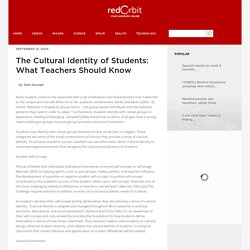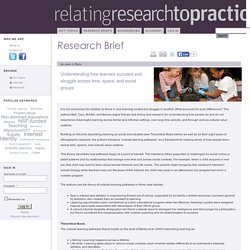

A Tale of Two Teachers. Adolescence and Internet Identity. The Cultural Identity of Students: What Teachers Should Know - Redorbit. September 21, 2005 by Sam Savage Every student conies to the classroom with a set of behaviors and characteristics that makes him or her unique and that will affect his or her academic achievement.

Banks and Banks (2005, 13) noted, "Behavior is shaped by group norms ... the group equips individuals with the behavior patterns they need in order to adapt. " Furthermore, students identify with certain groups to experience a feeling of belonging. Campbell (2004) stated that students of all ages have a strong need to belong to groups, because groups provide a source of motivation. Students may identity with certain groups because of race, social class, or religion. Student Self-Concept The set of beliefs that individuals hold about themselves is termed self-concept or self-image (Bennett 2003). Understanding how learners succeed and struggle across time, space, and social groups. It is not uncommon for children to thrive in one learning context but struggle in another.

What accounts for such differences? The authors Bell, Tzou, Bricker, and Baines argue that we lack theory and research for understanding how people do and do not experience meaningful learning across formal and informal settings, over long time periods, and through various cultural value systems. Building on theories describing learning as social and situated (see Theoretical Basis below) as well as on their eight years of ethnographic research, the authors introduce “cultural learning pathways” as a framework for making sense of how people learn across time, spaces, and cultural value systems. This theory describes how pathways begin at a point of interest. The interest is either supported or challenged by social norms or belief systems and by relationships that change over time and across social contexts.
Teaching Tolerance - Diversity, Equity and Justice. Educators today hear a lot about gaps in education – achievement gaps, funding gaps, school-readiness gaps.

Still, there's another gap that often goes unexamined: the cultural gap between students and teachers. "A bunch of teachers here, they think they know what's wrong with us. But they don't know. If people want to help us, they have to see what we've been through, not from what their own experiences tell them. " – Billie, a Lakota teen speaking of the teachers at her high school Most of us in the education profession are white, middle-class, monolingual-English speakers.
But the truth is: culture matters. Culture isn't just a list of holidays or shared recipes, religious traditions, or language; it is a lived experience unique to each individual. Hear elementary school teacher, Diane Holtam, speak about how she works with other teachers to disabuse stereotypic notions of Asian American students' abilities. Look For: Go Deeper: You're Asian, How Could You Fail at Math? Rebound by Kwame Alexander- Text for Students (partially Graphic)
Awkward- Graphic Text for Students. Discovering My Identity Lesson Plan. Diversity Printables, Lessons, and Resources For Teachers. Kandice Sumner: How America's public schools keep kids in poverty. How Cultural Differences Influence Adolescent Development. The parents of adolescents have the main responsibility of teaching children ethics.

Scholars of adolescent behavior and authors of "Family and Peer Influences on Adolescent Behavior and Risk-Taking," Nancy Gonzales and Kenneth Dodge, note that while much of adolescent development happens outside the home, the culture of the family instills upon children their developmental roots. Parents coming from difference cultures emphasize different value sets and therefore teach their children different moral standards.
For example, because honesty is an important concept in the West, American parents urge their children not to lie, even in situations where lying would be beneficial. On the contrary, parents from East Asia tend to focus on creating a sense of both social and family harmony. These parents are more willing to overlook lies, provided those lies contribute to harmony, such as in white lies that avoid hurting others' feelings. Identity in the world. Childhood Identity. I am ... I am not ... Teens' Identity. Self concept, self identity, and social identity. 5 Major Social And Emotional Problems In Adolescence. Why Identity and Emotion are Central To Motivating the Teen Brain.
Is your identity given or created? Best Middle School Books, As Chosen by Teachers. 9.

The Giver Quartet by Lois Lowry Jonas lives in a society in which the government controls everything: childbearing, careers, marriages. His utopia has sacrificed emotions and uniqueness in favor of a safe and predictable life. When Jonas learns that life could be different, he can never turn back to the life he’s always known. 10. Ponyboy and his brothers, Darry and Sodapop have a tough life. 11. On a trip to visit her mother’s grave, Sal learns about herself and her family. 12.
Is eternal life really that wonderful? 13. Bud Caldwell, is a 10 year old orphan who has grown up in Flint, Michigan. 14. Basketball-loving twins Josh and Jordan find their way through isolation and conflict in this novel in verse by master poet, Kwame Alexander. 15. Melinda Sordino can’t tell anybody why she called the police to break up a party the summer before ninth grade. 16. 17. Parvana is eleven when the Taliban comes to power in Afghanistan. 18. 19. 20.
Sociocultural & Critical Approaches to Literacy. Sociocultural approaches to literacy by Lina Trigos on Prezi.